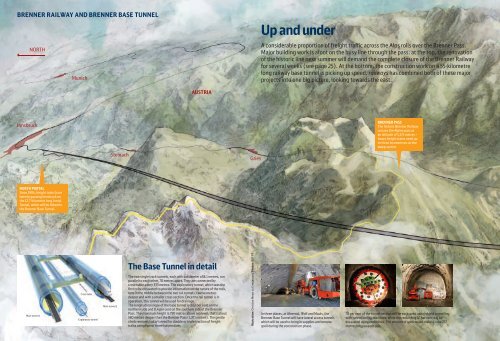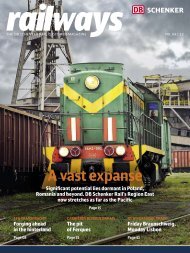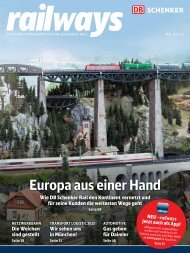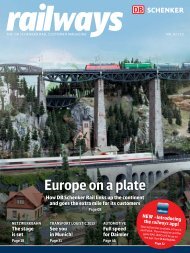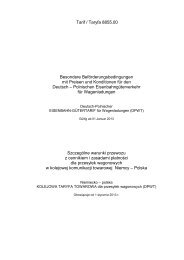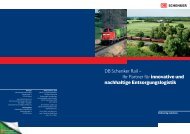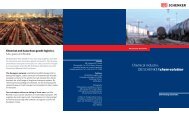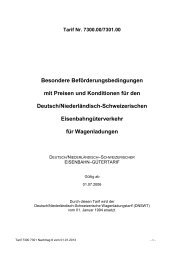Create successful ePaper yourself
Turn your PDF publications into a flip-book with our unique Google optimized e-Paper software.
BRenneR RAILWAY AnD BRenneR BAse tUnneL<br />
Innsbruck<br />
Up and under<br />
NORTH<br />
A considerable proportion of freight traffic across the Alps rolls over the Brenner Pass.<br />
Major building work is afoot on the busy line through the pass: at the top, the renovation<br />
SOUTH<br />
Munich<br />
of the historic line next summer will demand the complete closure of the Brenner <strong>Rail</strong>way<br />
for several weeks (see page 25). At the bottom, the construction work on a 55-kilometre<br />
long railway base tunnel is picking up speed. railways has combined both of these major<br />
projects into one big picture, looking towards the east.<br />
HIGHEST POINT<br />
The peak looming over the<br />
background is the Hochfeiler in<br />
the Zillertal Alps, which rises<br />
3,520 metres above sea level.<br />
ItALY<br />
NORTH PORTal<br />
Since 1994, freight trains have<br />
been bypassing Innsbruck on<br />
the 12.7-kilometre long Inntal<br />
Tunnel, which will be linked to<br />
the Brenner Base Tunnel.<br />
Main tunnel 1<br />
Cross-tube<br />
Exploratory tunnel<br />
Main tunnel 2<br />
Steinach<br />
AUstRIA<br />
the Base tunnel in detail<br />
The two single track tunnels, each with a diameter of 8.1 metres, run<br />
parallel to each other, 70 metres apart. They are connected by<br />
cross-tubes every 333 metres. The exploratory tunnel, which was the<br />
first to be excavated to provide information on the nature of the rock,<br />
runs in the middle between the two rail tunnels, twelve metres<br />
deeper and with a smaller cross section. Once the rail tunnel is in<br />
operation, this tunnel will be used for drainage.<br />
The longitudinal slope of the base tunnel is 0.67 per cent on the<br />
northern side and 0.4 per cent on the southern side of the Brenner<br />
Pass. The maximum height is 790 metres above sea level; that’s about<br />
580 metres deeper than the Brenner Pass (1,371 metres). The gentle<br />
climb removes today’s need for double or triple traction of freight<br />
trains using two or three locomotives.<br />
Gries<br />
Illustration: Christian Meyer zu Ermgassen / Photos: BBT PR<br />
In three places, at Ahrental, Wolf and Mauls, the<br />
Brenner Base Tunnel will have lateral access tunnels<br />
which will be used to bring in supplies and remove<br />
spoil during the construction phase.<br />
BRENNER PaSS<br />
The historic Brenner <strong>Rail</strong>way<br />
crosses the Alpine pass at<br />
an altitude of 1,371 metres –<br />
heavy freight trains need up<br />
to three locomotives on the<br />
steep sections.<br />
70 per cent of the tunnel section will be excavated using shield tunnelling<br />
with tunnel boring machines, while the remaining 30 per cent will be<br />
excavated using explosives. The amount of spoil would make a cube 257<br />
metres long on each side.<br />
Brennero<br />
Vipiteno<br />
(Sterzing)<br />
Fortezza<br />
(Franzensfeste)<br />
SOUTH PORTal<br />
On the Italian side, trains<br />
disappear into the Brenner<br />
Base Tunnel at Fortezza.<br />
60 per cent of the route is<br />
on Austrian territory.<br />
Berlin–Palermo<br />
The Brenner Base Tunnel is at the heart of a<br />
2,200-kilometre rail axis planned by the EU as<br />
Project 1 within its Trans-European Network<br />
(TEN).


